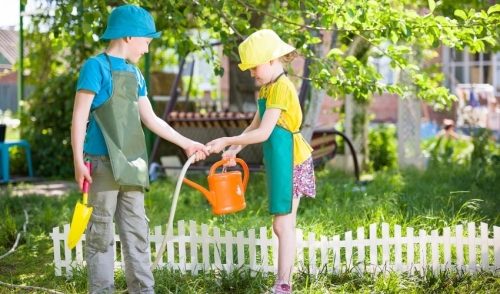
How to Start a Kid-Friendly Vegetable Garden
Getting kids involved with gardening is a great way not only to encourage youngsters to eat their vegetables, but to help them explore many other lessons and benefits gardens offer. But how can you start a kid-friendly vegetable garden?
How Gardening Helps Kids
A kid-friendly garden helps children be invested in their own health by growing delicious, healthy produce. At the same time, they will discover a greater diversity of food and come to understand the farm-to-table process. They will learn about the food web, the natural cycles of seasons, and the importance of bees and other pollinators. Gardening keeps kids outdoors in fresh air and gives them good exercise, as well as teaching valuable skills for future gardening efforts and a passion for eating healthier for a lifetime. As kids learn more about their gardens and see their harvests flourish, they will develop greater self-confidence, and their creativity and curiosity will be nourished just as their plants are. Gardening is even a great family activity that can involve multiple generations, strengthening family bonds and relationships.
In order to realize this great harvest of benefits, however, a garden must be kid-friendly.
Tips for a Kid-Friendly Vegetable Garden
A kid-friendly garden isn’t that different from any traditional garden, but it must be better suited to smaller hands, youthful energy, and developing skills. Keeping kids involved in the garden from start to finish is essential for them to feel a part of the entire effort, and there are many ways to add kid-friendly elements to a vegetable garden.
- Use a kid-sized space.
Young gardeners can lose interest or get overwhelmed by a very large garden. Instead, offer them their own kid-sized garden space, such as their very own row in the larger garden, a container for their own plants, or even a raised garden bed dedicated just to them. This will be less intimidating but will still allow them the freedom to explore all aspects of gardening.
- Provide ownership of the garden.
Nothing will make a budding gardener happier than knowing a bit of the garden truly is theirs. Let them make decisions about where to position different plants, and provide a sign with their name to show the world that part of the garden belongs to them. This will also help improve their self-esteem and keep them invested in the garden’s growth and performance.
- Use real, but kid-friendly, tools.
Smaller hand tools are appropriate for young gardeners, but be sure the tools are safe and easy for little hands to manage. Avoid treating toy garden tools as if they are the real thing – instead, give kids the opportunity to use “grown up” tools and teach them proper tool use and safety. Tools with handles in fun colors can be especially engaging for youngsters.
- Let kids choose their own veggies.
Children will be more eager to work in the garden if they like the plants they’re growing. Let them choose their favorite vegetables (or even a fruit or two), so they can learn about every stage of the plant. Corn, potatoes, carrots, beans, peas, and small cherry or grape tomatoes are kid-friendly favorites.
- Incorporate creativity.
A kid-friendly garden doesn’t need to be strict, straight, and regimented. Let young gardeners plant in uneven rows, circles, or even wedges or other fun shapes if that appeals to their imagination. Let them choose new plants that look fun and colorful, and you never know what new vegetable they may come to love as they grow it themselves.
- Add some fun plants.
Bring extra plants into a kid-friendly garden, just for fun. A tall sunflower is an excellent choice that kids will love to see sprout up, or add some flowers in their favorite colors to attract natural pollinators. Adding some other extraordinary plants, such as a pumpkin or watermelon vine, can keep kids engaged and interested in the garden.
- Create a schedule kids will understand.
Use a calendar, whiteboard, or notebook to create a vegetable garden to-do list so kids can keep track of their own schedule. Include all necessary chores such as weeding, watering, and pruning, and don’t forget to note the planting dates and expected harvest dates so kids can count down and see their efforts rewarded.
- Make garden chores into fun games.
Young gardeners may occasionally need encouragement to do their outdoor chores. Make those chores into fun games, such as making weeding a race, allowing a bit of water fight fun while watering plants, or creating a scavenger hunt for pests to get kids involved and add a bit of cheerful play to garden tasks.
- Become friends with bugs.
Bugs, worms, butterflies, and all manner of creepy-crawlies fascinate children. Use that fascination to teach them about both beneficial bugs as well as unwelcome pests in the garden. Get a bug identification book for extra learning, or make room for good bugs in the garden with a butterfly feeder or bee house.
- Go beyond the garden.
When the harvest is ready, move past the garden by teaching the child how to prepare a new recipe with the produce they’ve grown, or how to pickle, can, and preserve their bounty. This will show them the ongoing benefit of gardening, as well as let them relive the joy they’ve found in their garden long after the harvest has ended.
- Supervise without stifling and be patient, not perfect.
No new gardener – of any age – will have an ideal harvest the first time they try to grow something. Gently guide and teach children in the garden, but allow them to experiment and even make educational mistakes. Praise their efforts and help them feel welcome in the garden, and they’ll want to return with every growing season.
Gardening is a great activity for all ages, and a kid-friendly vegetable garden is a great way to teach youngsters valuable skills, enjoyment, and sharing that will bring them a lifetime of tasty benefits.

